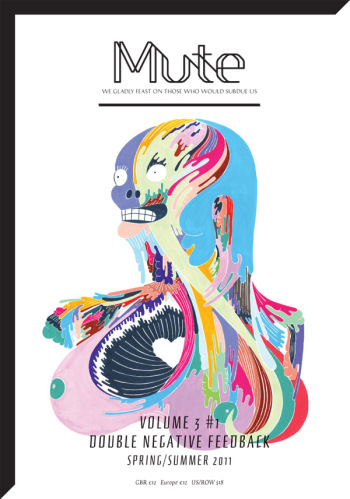Mute, 3(1): Double Negative Feedback (2011)
Filed under magazine | Tags: · architecture, art, capitalism, contemporary art, cultural politics, economics, financial crisis, journalism, music, neoliberalism, networks, politics, uk, wikileaks

“‘Double Negative Feedback’ expresses the hope that the chaos unleashed by the cybernetic loops of financialisation, post-Fordist production and networked life might not only be entropic and exploitative. The noise generated by ‘positive feedback’ also takes the form of the explosions we are seeing in the Arab world, the anti-disciplinary uses of cybernetic control systems, the ‘shared precarity’ of compositional improvising, and the ripples of a political organising that no longer assumes a common identity but instead acknowledges our common vulnerability. This issue scouts out such double-negative loops in a landscape dominated by the relentless, if often misfiring attempt to put feedback to work.”
Edited by Josephine Berry Slater
Publisher Mute, London, June 2011
Craig J. Saper: Networked Art (2001)
Filed under book | Tags: · art, bureaucracy, conceptual art, concrete poetry, fluxus, lettrism, mail art, network culture, networks, poetry, visual poetry

“Outlines an exciting new approach to this confluence of art, media, and poetry.
The experimental art and poetry of the last half of the twentieth century offers a glimpse of the emerging networked culture that electronic devices will make omnipresent. Craig J. Saper demarcates this new genre of networked art, which uses the trappings of bureaucratic systems—money, logos, corporate names, stamps—to create intimate situations among the participants.
In Saper’s analysis, the pleasures that these aesthetic situations afford include shared special knowledge or new language among small groups of participants. Functioning as artworks in themselves, these temporary institutional structures—etworks, publications, and collective works—give rise to a gift-exchange community as an alternative economy and social system. Saper explains how this genre developed from post-World War II conceptual art, including periodicals as artworks in themselves; lettrist, concrete, and process poetry; Bauhaus versus COBRA; Fluxus publications, kits, and machines; mail art and on-sendings. The encyclopedic scope of the book includes discussions of artists from J. Beuys to J. S. G. Boggs, and Bauhaus’s Max Bill to Anna Freud Banana. Networked Art is an essential guide to the digital artists and networks of the emerging future.”
Key words and phrases: Fluxus, concrete poetry, mail art, mail artists, visual poetry, Dick Higgins, Big Dada, conceptual art, Ray Johnson, George Maciunas, sound poetry, Ken Friedman, Guy Bleus, Bauhaus, detournement, neoist, Max Bill, Augusto de Campos, George Brecht, Joseph Beuys
Publisher University of Minnesota Press, 2001
ISBN 0816637075, 9780816637072
198 pages
PDF, PDF (updated on 2018-9-21)
Comments (3)Roy Ascott: Telematic Embrace: Visionary Theories of Art, Technology, and Consciousness (2003)
Filed under book | Tags: · art, conceptual art, consciousness, cyberspace, electronic art, networks, technology, telematics, telepresence

Long before e-mail and the Internet permeated society, Roy Ascott, a pioneering British artist and theorist, coined the term “telematic art” to describe the use of online computer networks as an artistic medium. In Telematic Embrace Edward A. Shanken gathers, for the first time, an impressive compilation of more than three decades of Ascott’s philosophies on aesthetics, interactivity, and the sense of self and community in the telematic world of cyberspace. This book explores Ascott’s ideas on how networked communication has shaped behavior and consciousness within and beyond the realm of what is conventionally defined as art.
Telematics, a powerful marriage of computers and telecommunication, made technologies we now take for granted—such as e-mail and automated teller machines (ATMs)—part of our daily life, and made art a more interactive form of expression. Telematic art challenges traditional relationships between artist, artwork, and audience by allowing nonlocal audiences to influence the emergent qualities of the artwork, which consists of the ebb and flow of electronic information. These essays constitute a unique archaeology of ideas, tracing Ascott’s meditations on the formation of consciousness through the intertwined cultural histories of art and technology from the 1960s to the present.
Shanken’s introduction situates Ascott’s work within a history of ideas in art, technology, and philosophy. Given the increasing role of the Internet and the World Wide Web in the creation of commerce and community at the dawn of this new millennium, scholars, students, laypeople, policymakers, and artists will find this collection informative and thought-provoking.
Edited and with an essay by Edward A. Shanken
Published by University of California Press, 2003
ISBN 0585465916, 9780585465913
427 pages
PDF (updated on 2012-7-24)
Comment (0)
